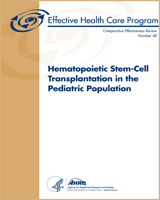NCBI Bookshelf. A service of the National Library of Medicine, National Institutes of Health.
Ratko TA, Belinson SE, Brown HM, et al. Hematopoietic Stem-Cell Transplantation in the Pediatric Population [Internet]. Rockville (MD): Agency for Healthcare Research and Quality (US); 2012 Feb. (Comparative Effectiveness Reviews, No. 48.)
This publication is provided for historical reference only and the information may be out of date.

In all studies, serum C-peptide levels were measured using radioimmunoassay. To accommodate differences in data presentation and analysis, they are presented in the tables as a percentage change from values at study entry.
C-Peptide Level
Data on C-peptide levels were reported in all three studies included in this review, at follow-up times that range from 6 months in one IIT study (Crino et al, 2005, rec#23080) to more than 4 years in the HSCT study (Couri et al, 2009, rec#290) (Table F1). The proportional change in C-peptide levels in the HSCT study refer only to patients who remained continuously insulin free.
AppendixTable F1
C-peptide levels following autologous HSCT or IIT in pediatric patients.
The data in Table F1 show that C-peptide levels following a mixed-meal tolerance test were significantly increased above baseline values in the HSCT study (Couri et al, 2009, rec#290) for more than two years in 8 of 12 patients who became continuously insulin free following the procedure. In one IIT study, mean fasting C-peptide levels were not changed significantly at 1 or 2 years following initiation of treatment from that at study entry (Crino et al, 2005, rec#23080). In the second IIT study, the mean C-peptide level following a Boost meal test was slightly lower at 6 months following initiation of treatment than that at study entry (Mastrandrea et al, 2009, rec#40050).
Hemoglobin A1C Levels
Table F2 shows HbA1C levels in patients treated with nonmyeloablative autologous HSCT (Couri et al, 2009, rec#290) or IIT (Crino et al, 2005, rec#23080; Mastrandrea et al, 2009, rec#40050).
AppendixTable F2
HbA1C levels following autologous HSCT or IIT in pediatric patients.
Hemoglobin A1C (HbA1C) levels pretransplant ranged from 5.4% to 11.6% (mean 8.4 ± 1.6%) among 18 pediatric patients in the HSCT study (Couri et al, 2009, rec#290). Among those who became continuously insulin-free, HbA1C declined from a mean 8.0% to 5.7%, 5.7%, 5.5%, and 6.0%, respectively, at 12, 24, 36, and 48 months after transplantation (p < 0.001 at all time points versus pretreatment value).
In one IIT study, HbA1C did not change significantly from a mean 10.5 ± 2.2% at diagnosis to 5.4 ± 0.8% and 6.5 ± 0.9% at 12 and 24 months, respectively (Crino et al, 2005, rec# 23080). In the second IIT study, mean HbA1C at study entry (12.4 ± 2.5%) declined to an average 7.0 ± 1.2% (p-value NR) (Mastrandrea et al, 2009, rec#40050).
- C-Peptide and HbA1c Outcomes - Hematopoietic Stem-Cell Transplantation in the Pe...C-Peptide and HbA1c Outcomes - Hematopoietic Stem-Cell Transplantation in the Pediatric Population
- RecName: Full=POU domain, class 5, transcription factor 1; AltName: Full=Octamer...RecName: Full=POU domain, class 5, transcription factor 1; AltName: Full=Octamer-binding protein 3; Short=Oct-3; AltName: Full=Octamer-binding protein 4; Short=Oct-4; AltName: Full=Octamer-binding transcription factor 3; Short=OTF-3gi|400659|sp|Q01860.1|PO5F1_HUMANProtein
- ATPase family gene 2 protein homolog A isoform X3 [Mus musculus]ATPase family gene 2 protein homolog A isoform X3 [Mus musculus]gi|1039764772|ref|XP_017175162.1|Protein
- PREDICTED: Mustela putorius furo caveolin 1 (CAV1), transcript variant X2, mRNAPREDICTED: Mustela putorius furo caveolin 1 (CAV1), transcript variant X2, mRNAgi|2130914902|ref|XM_004741921.3|Nucleotide
- Caenorhabditis elegans Protein containing ALS2cr12 (ALS2CR12) signature (F42C5.3...Caenorhabditis elegans Protein containing ALS2cr12 (ALS2CR12) signature (F42C5.3), partial mRNAgi|1845975742|ref|NM_001306900.2|Nucleotide
Your browsing activity is empty.
Activity recording is turned off.
See more...